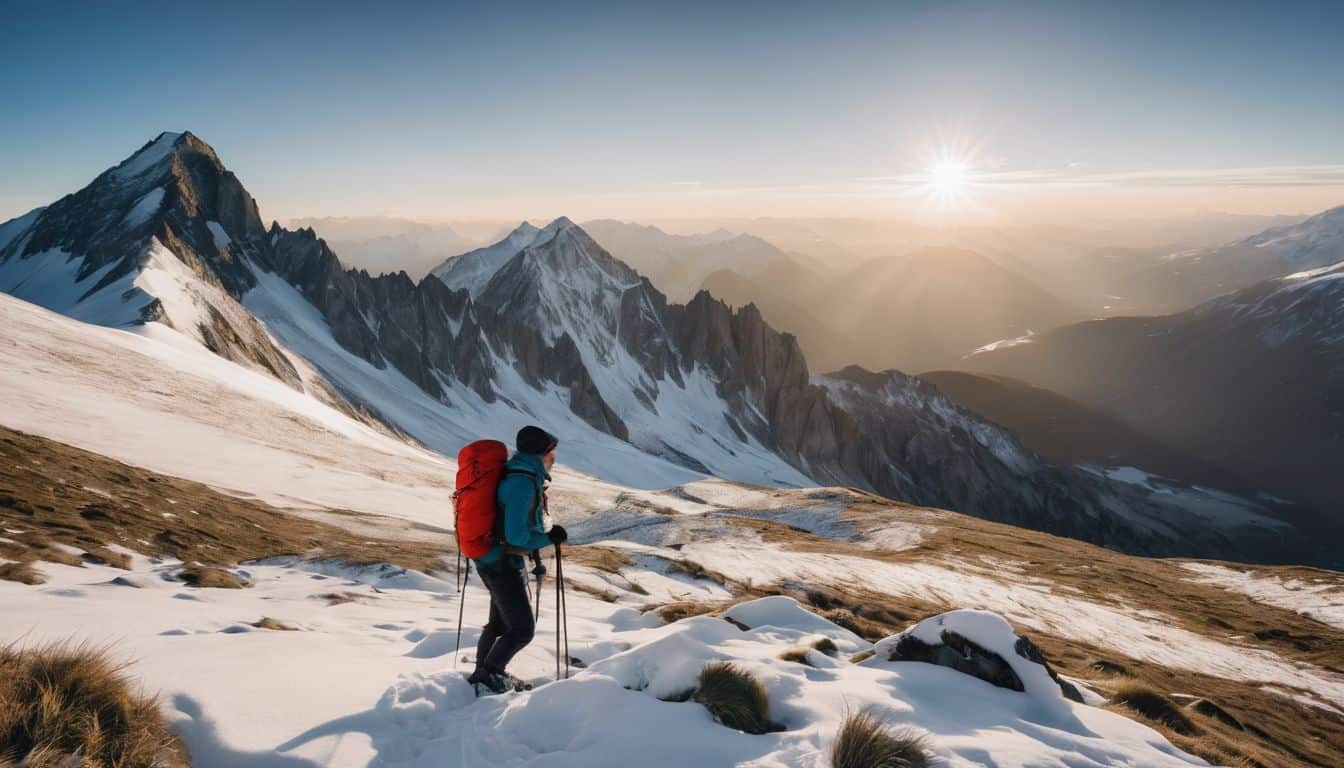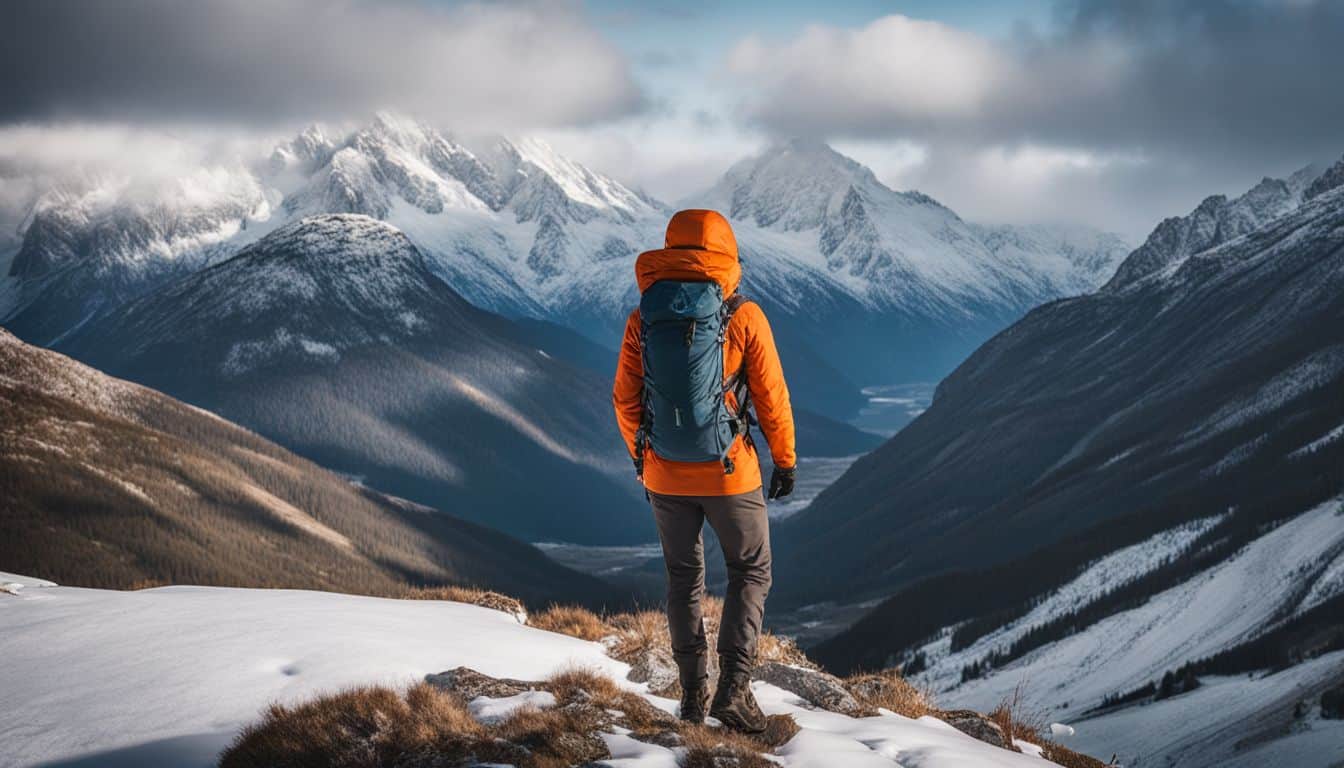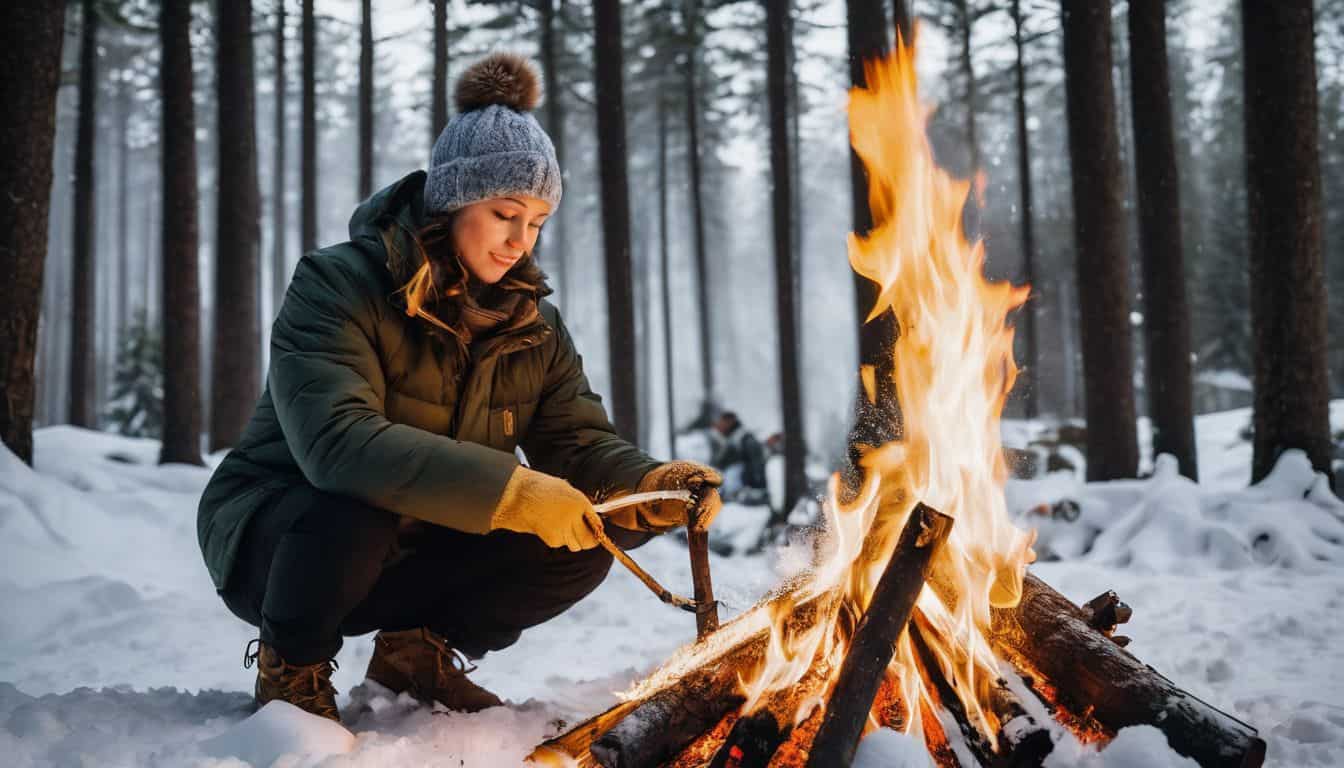Braving the harsh, cold weather survival guide conditions can sometimes feel like a battle of will. Trust me, I know exactly what you’re going through; I’ve felt that biting chill seeping into my bones as well.
In fact, approximately 1,300 US deaths each year are a direct result of exposure to relentless natural cold! That’s why I have put together this comprehensive guide brimming with practical steps and insights on extreme winter survival – from dressing aptly for the biting winds to locating food sources amidst blankets of snow.
Intrigued? Let’s step out side by side on this frosty journey towards mastering cold weather survival techniques. Let’s turn surviving in freezing temperatures from an intimidating ordeal into a manageable feat together.
Key Takeaways
- Dress in layers using thermal underwear, insulated jackets, boots, and gloves to stay warm in cold weather.
- Cover exposed body parts like the head, ears, nose, and fingers with hats, scarves, gloves, and hand warmers to prevent frostbite.
- Stay dry by wearing moisture – wicking fabrics and waterproof outer layers to avoid hypothermia.
- Learn basic cold weather survival skills such as creating a fire for warmth and building a shelter for protection.
Essential Cold Weather Clothing and Gear
To master cold weather survival, it is crucial to pack the right cold weather clothing and gear. Layering techniques, proper gloves, mittens, hats, and footwear are essential for staying warm.
Additionally, covering exposed body parts and staying dry will help prevent frostbite and hypothermia in extreme cold conditions.
Pack cold weather clothing
Always pack warm clothes for cold weather. Start with thermal underwear, it’s the best first layer. Then add more layers. Insulated jackets, boots, and gloves are important too. Pack a good parka, it will keep you very warm! Don’t forget scarves and beanies to cover your head and neck from the cold air and wind.
Fleece jackets add extra warmth without much weight. Snow pants are great when there is a lot of snow on the ground. Hand warmers can be also used for added heat in your pockets or gloves! You can pack all these items even in a small bag if packed right.
Layering techniques
Layering is a key part of staying warm in the cold. Here are some layering tips to help you:
- Always start with a base layer. This should be snug and made of warm material.
- The next step is an insulation layer like Thinsulate or Primaloft.
- Then, add an outer layer to block wind and snow.
- For your feet, use thick socks and warm boots.
- Cover your head and hands with hats and gloves.
- If it’s very cold, add extra layers as needed.
Proper gloves, mittens, hats, and footwear
I know how crucial it is to wear the right clothes in cold weather. The first thing I do is choose good gloves. I go for insulated ones with a waterproof shell. They stand up well to the cold. Next, I get mittens. They make my hands warm by keeping my fingers together. My hat choice is always thermal ones. They keep my head and ears cozy and warm.
Covering exposed body parts
When it’s cold outside, it’s important to cover up your body parts to protect them from the freezing temperatures and wind. Exposing your skin to the cold can lead to frostbite, which is a serious health risk.
So make sure you cover your nose, cheeks, ears, and fingers with warm clothing and accessories like scarves, hats, ear muffs, insulated gloves, hand warmers, face masks, and neck warmers.
These items will help keep you safe from frostbite and other injuries caused by extreme cold weather. Stay warm and take care of yourself!
Staying dry
It’s crucial to stay dry when you’re out in cold weather. Moisture can make you feel colder and increase the risk of hypothermia. To stay dry, it’s important to wear moisture-wicking fabrics that pull sweat away from your body.
Choose insulating materials like wool instead of cotton, as they repel moisture and keep you warm. Wear windproof outer layers to protect against snow and rain. Make sure your boots are waterproof to keep your feet dry.
Invest in thermal socks, insulated gloves, fleece jackets, and wind-resistant hats for extra protection against moisture. Remember, staying dry is key in cold weather survival!
Basics of Cold Weather Survival (https://natureofthenorth. co/basics/Cold-weather-survival-guide)
When it comes to surviving in cold weather, there are some basic things you need to know. First and foremost is the importance of staying warm. Layering your clothing is key in keeping your body heat trapped and insulating yourself from the cold.
It’s also crucial to cover up any exposed body parts, like your head, neck, hands, and feet. These areas tend to lose heat quickly.
Another important factor in cold weather survival is staying dry. Moisture can make you feel even colder and increase the risk of hypothermia. So be sure to pack waterproof gear or clothing that dries quickly.
Additionally, it’s essential to have knowledge of creating a fire and building a shelter for protection against extreme cold temperatures. Fires provide warmth and can help you cook food if needed.
As for shelters, they offer insulation and shield you from wind chill.
Lastly, one key point to remember is minimizing travel during extreme cold conditions unless absolutely necessary. If you do need to go out, always carry a winter survival kit with essentials like food rations, water, extra clothing layers, blankets or sleeping bags, flashlights or headlamps with spare batteries.”.
Food and Hydration for Winter Survival
Proper food preparation and staying hydrated are crucial for winter survival.
Winter survival food preparation
Winter survival food preparation is crucial when facing cold weather conditions. Here are some important tips to consider:
- Stock up on non-perishable survival food: In your winter survival kit, make sure to include foods that have a long shelf life and do not require refrigeration. This way, you can have sustenance even in extreme conditions.
- Opt for lightweight food: When selecting your survival food, choose options that are lightweight and easy to carry. This will ensure that you can take them with you if you need to evacuate or move around.
- Include plenty of simple sugars: Simple sugars provide quick energy and can help regulate body temperature in cold weather. Include snacks or foods that contain high levels of carbohydrates to keep your energy levels up.
- Consider root veggies: Root vegetables like carrots, beets, and turnips can withstand cold temperatures and are a good source of nutrients. They can be stored for longer periods and provide essential vitamins during winter survival situations.
- Plan for emergency food growth: In snowy months, it’s still possible to find emergency food sources in nature. Research which plants grow in winter and learn how to identify them. This knowledge may come in handy during an emergency situation.
Importance of staying hydrated
Staying hydrated is really important, especially in the winter months. It helps to keep us warm, healthy, and comfortable. We might think that dehydration only happens in the summer when it’s hot out, but it can actually happen in cold weather too.
Drinking enough water is crucial for maintaining our fluid balance and avoiding dehydration. In the winter, the air tends to be drier which increases the risk of dehydration. So it’s important to make sure we’re drinking enough water throughout the day.
Staying hydrated is not only good for our overall health and wellness, but it also helps with managing chronic diseases and preventing cold-related health risks.
Planning and staying on schedule
To stay safe and healthy during cold weather, it’s important to plan ahead and stick to a schedule. Making a detailed plan before heading out can help you avoid unnecessary risks. Check the weather forecast and plan your activities accordingly.
Make sure you have enough food, water, and supplies for the duration of your trip. It’s also essential to stay hydrated, even if water is limited. Pack high-energy snacks that are easy to eat on the go.
Finally, don’t forget to bring a watch or some other way to keep track of time so you can stay on schedule and make sure you have enough daylight for your activities.
Maintaining Body Temperature
To maintain body temperature in cold weather, it’s important to control your heart rate and build a fire for warmth. Learn more about these essential techniques and how to create a cold weather shelter in our complete cold weather survival guide.
Stay warm and survive the winter!
Controlling heart rate
Our heart rate plays a crucial role in maintaining our body temperature, especially in cold weather. When we are exposed to low temperatures, our heart rate tends to increase as it works harder to keep us warm and maintain circulation throughout the body.
It’s important to control our heart rate in order to prevent any complications or health issues.
In cold weather, our blood vessels constrict, which can lead to reduced blood flow and increased strain on the heart. This is why it’s essential to take steps to regulate our heart rate and ensure optimal circulation.
One way to do this is by staying active and regularly moving around. Engaging in light exercises or activities can help keep your blood flowing more efficiently.
Additionally, deep breathing exercises can also be helpful for controlling your heart rate. Taking slow, deep breaths helps relax the body and reduces stress levels, which can indirectly influence your heart rate.
Building a fire
Building a fire is crucial for maintaining body temperature in cold weather survival. It provides heat and can attract attention in extreme cold conditions. Here are some important tips to remember:
- Find a suitable location for your fire, away from flammable materials and sheltered from wind.
- Gather dry wood and kindling to start your fire. Look for dead branches or fallen trees that are off the ground.
- Arrange the wood in a teepee or log cabin structure, allowing enough airflow for the fire to burn well.
- Use a fire starter, such as matches or a lighter, to ignite the kindling. Start with smaller pieces of wood before adding larger ones.
- Keep feeding your fire with additional wood to maintain the heat. Ensure you have enough fuel gathered beforehand.
- Create a reflective wall behind your fire by stacking rocks or using any available material. This helps retain and reflect heat towards you.
- Make sure you have enough ventilation around your fire to avoid smoke inhalation. Position yourself upwind from the smoke.
- Always monitor your fire and keep it under control. Do not leave it unattended, especially during windy conditions.
- When extinguishing your fire, douse it with water and stir the ashes until they are cool to the touch.
Creating a cold weather shelter
When you’re out in extreme cold conditions, creating a cold weather shelter is crucial for maintaining your body temperature. Here are some important ways to create an effective shelter:
- Choose a suitable location: Look for a spot that offers protection from wind and precipitation. It could be under trees, behind rocks, or against a hillside.
- Insulate the ground: Lay down a layer of insulation, like pine branches or dry leaves, to prevent the cold ground from leaching away your body heat.
- Build a sturdy structure: If possible, construct a shelter using natural materials such as branches, logs, and snow blocks. Make sure it’s strong enough to withstand the elements.
- Block drafts: Use additional materials like tarps or emergency blankets to cover any openings and reduce drafts inside the shelter.
- Maximize heat retention: Make your shelter smaller and more compact to maximize heat retention. This will help trap your body heat inside and keep you warmer.
Avoiding Cold Weather Illnesses
To avoid cold weather illnesses like frostbite and hypothermia, it is important to recognize the symptoms and take preventative measures such as dressing in appropriate layers, avoiding prolonged exposure to extreme cold, and keeping the body warm with proper insulation.
Recognizing and preventing frostbite and hypothermia
Frostbite and hypothermia are serious risks when it’s very cold outside. It’s important to know the signs and take precautions to prevent them. Here are some tips:
- Watch for numbness in your fingers, toes, or other exposed body parts.
- Check for pale or waxy skin on those areas as well.
- Pay attention if you start shivering uncontrollably, as this can be a sign of hypothermia.
- Keep an eye out for any confusion or difficulty speaking, another sign of hypothermia.
- Seek medical help immediately if you notice any of these symptoms.
- Make sure to dress warmly and layer your clothing to trap heat close to your body.
- Wear proper gloves, mittens, hats, and warm footwear to protect your extremities.
- Cover up any exposed skin with scarves or masks to shield it from the cold air.
- Stay dry by wearing waterproof clothing and avoiding wet conditions.
- Seek shelter from the wind by finding a protected area or creating a windbreak.
Other common cold weather illnesses to avoid
Winter weather can bring about various illnesses that we need to be careful of. Here are some common cold weather illnesses to avoid:
- Hypothermia: This happens when our body loses heat faster than it can produce it. Symptoms include shivering, exhaustion, confusion, and slurred speech.
- Frostbite: When our skin and body tissue freeze, frostbite can occur. Protecting ourselves from extreme cold is crucial to prevent this.
- Trench foot: Spending too much time in wet and cold conditions can lead to trench foot, a condition that affects the feet.
- Respiratory illnesses: Cold weather increases the risk of respiratory illnesses like the common cold, flu, bronchitis, pneumonia, and whooping cough.
Winter Foraging and Food Sources
Finding food sources in winter conditions can be challenging, but with the right knowledge and techniques, it is possible to sustain yourself in the wilderness during the colder months.
Finding food sources in winter conditions
Winter foraging is an important skill for survival enthusiasts like us. When it comes to finding food sources in winter conditions, there are plenty of options available. Here are some key points to consider:
- Abundance of wild foods: Despite the cold temperatures, there is an abundance of wild foods that can be foraged even in cold climates. In Vermont alone, over 50 wild foods are available for winter foraging.
- Emergency food sources: Winter foraging focuses on finding emergency food sources that grow in snowy conditions. These edible plants can provide sustenance during challenging times.
- Specific food sources: Some specific food sources for winter survival include cattail roots, pine nuts, milkweed seeds, acorns, and watercress. These can be found in various regions and offer valuable nutrients.
- Edible and medicinal plants: Winter foraging not only yields edible plants but also provides access to medicinal plants. These plants can be used to treat common ailments or support overall health and well-being.
- Wide variety of options: In colder climates like Canada and the U.S., there is a list of over 65 wild foods, herbs, berries, greens, fungi, and mushrooms that can be found during winter. This offers a diverse range of options for foragers.
Winter foraging tips
Winter foraging can be tough, but with the right tips and tricks, you can find food even in the cold. Here are some tips for winter foraging:
- Look for evergreen trees: These trees can provide edible needles and bark that you can use as a source of nutrition.
- Search for dormant plants: Some plants may appear dead during the winter, but they are still edible. Look out for plants like chickweed and sorrel that can survive in cold weather.
- Use your sense of smell: Certain plants have distinct smells, even in winter. Follow your nose to locate herbs like thyme and rosemary that can be used in cooking or as medicinal herbs.
- Dig under the snow: Underneath the snow, you may find roots or bulbs of certain plants that are still good to eat. Be careful not to damage them while digging.
- Focus on areas with sunlight: South-facing slopes or areas where sunlight hits more often tend to have more plant growth during winter.
- Learn about wild mushrooms: While it’s important to be cautious when identifying mushrooms, some species like turkey tail and reishi grow even in colder months and have potential health benefits.
- Identify winter berries: Berries such as rose hips and juniper berries are high in vitamin C and can be found on certain shrubs during winter.
- Stay safe and prepared: Always dress warmly, carry necessary equipment like a compass or map, and inform someone about your plans before you go out foraging.
Staying Calm and Clear-Headed
Maintaining a calm mindset is crucial in cold weather survival situations, and there are various techniques to stay focused and clear-headed amidst the challenging conditions.
Importance of maintaining a calm mindset in cold weather survival situations
In cold weather survival situations, it’s really important to stay calm and clear-headed. When faced with challenging conditions, keeping a composed and resilient mindset can make a big difference.
When you maintain your serenity and steadiness, you’re able to think more clearly and make better decisions for yourself and others around you.
Drinking water and taking deep breaths can help you stay calm in stressful moments. Having clarity of mind is crucial when working to keep yourself safe and find solutions in difficult situations.
Techniques for staying focused and clear-headed
When surviving in cold weather, it’s important to stay focused and clear-headed. Here are some techniques that can help:
- Deep Breathing: Take slow, deep breaths to calm your mind and increase oxygen flow to the brain. This can improve concentration and mental clarity.
- Stay Hydrated: Dehydration can affect cognitive function and make it harder to think clearly. Be sure to drink enough water regularly to stay hydrated.
- Practice Mindfulness: Pay attention to the present moment and avoid getting lost in negative thoughts or worries. Mindfulness can help reduce stress and enhance focus.
- Utilize Relaxation Techniques: Engage in activities like meditation, yoga, or deep breathing exercises to relax your body and mind. This can improve cognitive focus and emotional stability.
- Prioritize Sleep: Getting enough rest is crucial for optimal cognitive function. Aim for 7-9 hours of quality sleep each night to maintain clarity of thought.
- Problem-Solving Skills: Develop effective problem-solving skills to address challenges quickly and efficiently. This will help you stay focused on finding solutions rather than getting overwhelmed by obstacles.
- Stay Positive: Maintain a positive mindset even in difficult situations. Optimism can enhance resilience and keep you motivated during cold weather survival scenarios.
Tips from Cold Weather Experts
Learn from experienced individuals who have mastered cold weather survival with their valuable advice and tips.
Advice and tips from experienced individuals who have mastered cold weather survival
I’ve learned a lot from experienced individuals who have mastered cold weather survival. They stress the importance of being prepared and dressing appropriately for extreme weather conditions.
Layering your clothing and wearing proper hats, mittens, and footwear are essential to staying warm. They also emphasize the need to stay hydrated to maintain good blood flow and bodily functions.
In addition, they recommend minimizing travel during extreme cold weather and having a winter survival kit in your vehicle if you must travel. These tips have been invaluable in helping me navigate through cold weather situations with confidence.
Additional things to Consider
Stay warm and comfortable by wearing multiple layers, investing in quality winter gear, and utilizing new warmth sources like hand warmers or heated blankets. Don’t let the cold weather stop you from enjoying outdoor activities – embrace winter and make the most of it!
Tips for staying warm and comfortable
Staying warm and comfortable in cold weather is essential for survival. Here are some tips to help you:
- Layer your clothing: Wear thermal layers and insulating materials to trap warm air close to your body.
- Keep your head, hands, and feet covered: Wear a hat, gloves or mittens, and insulated footwear to protect these areas from the cold.
- Avoid sweating: Pace yourself and remove layers if you start to sweat. Sweating can make you feel colder once you stop moving.
- Stay dry: Moisture can make you feel colder, so avoid getting wet and change into dry clothing if necessary.
- Share body heat: If possible, use the buddy system and huddle together to share body heat and stay warm.
- Eat high-energy foods: Certain foods like carbohydrates and fats can increase your internal heat production, keeping you warm.
- Take breaks indoors: If possible, take regular breaks in warm indoor spaces to relax and warm up before going back outside.
- Use hand warmers or heated packs: Carry hand warmers or heated packs with you for instant warmth when needed.
Taking advantage of new warmth sources
In cold weather survival situations, it’s important to find new sources of warmth to stay safe and comfortable. One option is to use heat sources like a campfire or portable heater.
These can provide much-needed warmth and help prevent hypothermia. Another option is to insulate your clothing and gear with materials that trap heat, such as thermal blankets or reflective layers.
These can keep your body heat from escaping and keep you warmer for longer. It’s also helpful to find shelter from the wind and elements, like a cave or thick trees, which can act as natural barriers against the cold.
Engaging in outdoor activities
For those of us who love outdoor activities, don’t let the cold weather stop you from having fun! Winter is a great time to enjoy outdoor recreation and try new winter sports. Whether it’s skiing, snowboarding, ice skating, or even just taking a hike in the snowy woods, there are plenty of ways to stay active and enjoy the beauty of nature during the winter months.
Just remember to dress appropriately for the cold weather by wearing layers, including a good quality winter jacket and insulated boots. Don’t forget your hat and gloves too! Also, make sure to follow fire safety guidelines if you plan on building a fire for warmth or cooking.
With proper preparation and gear, engaging in outdoor activities can be an exciting and fulfilling experience even in cold weather. So go out there and embrace the winter adventure!
Conclusion
In conclusion, mastering cold weather survival is all about being prepared and staying informed. By packing the right clothing and gear, knowing how to stay warm and hydrated, avoiding common cold weather illnesses, and learning from experts in the field, you can navigate through extreme cold conditions with confidence.
So embrace winter adventures with these nine ways to master cold weather survival!
FAQs
1. How can I stay warm in cold weather?
You can stay warm in cold weather by dressing in layers, wearing a hat and gloves, and using blankets or heat packs.
2. What should I do if I get stranded in the snow?
If you get stranded in the snow, it’s important to stay with your vehicle for shelter and warmth, call for help if possible, and conserve energy by avoiding unnecessary activities.
3. How can I prevent frostbite during cold weather?
To prevent frostbite during cold weather, make sure to cover exposed skin, wear insulated boots and socks, avoid prolonged exposure to extreme temperatures, and keep moving to improve circulation.
4. What are some tips for driving in icy conditions?
Some tips for driving in icy conditions include reducing speed, keeping a safe distance from other vehicles, using gentle braking and acceleration techniques, and avoiding sudden turns or lane changes.
5. What are some signs of hypothermia to watch out for?
Signs of hypothermia include shivering uncontrollably or not at all, confusion or memory loss, slowed breathing or heart rate, slurred speech or clumsiness. If someone shows these signs it is important to seek medical attention immediately.







Leave a Reply